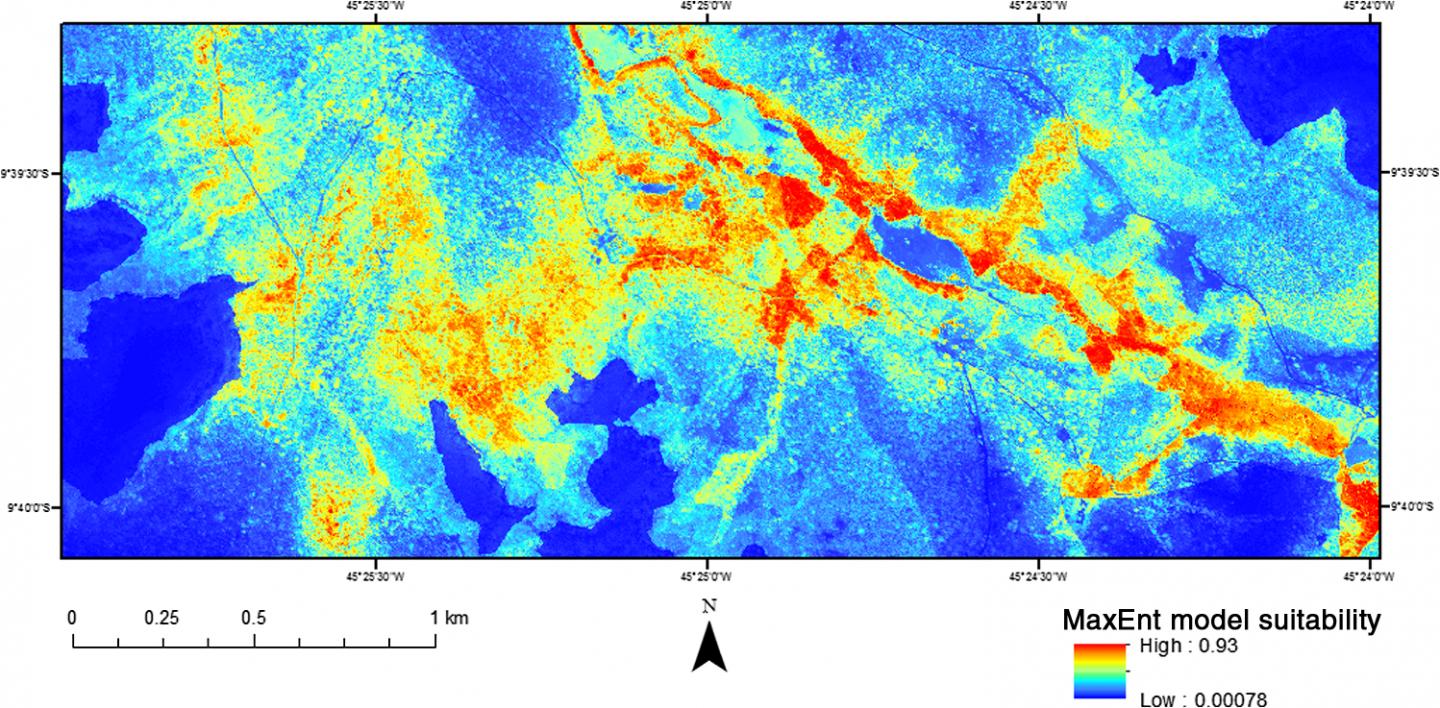Biologists and psychologists are fascinated by the bearded capuchin monkeys (Sapajus libidinosus) of northeastern Brazil, which exhibit behavior that is extremely rare in the animal kingdom: they use stone tools to crack open the hard casings of palm nuts, to eat the meat inside.
Scientists eager to study this behavior -- especially interesting because it resembles the stone tool use of early hominids -- are concerned the monkeys will lose critical habitat as industrial agriculture is rapidly expanding and intensifying in the region. They seek a way to set priorities for their protection.
"Remote sensing and habitat mapping for bearded capuchin monkeys (Sapajus libidinosus): landscapes for the use of stone tools" explains how researchers applied remote sensing and geographic information systems to the characterization of capuchin habitat, as an initial step in identifying and protecting their range.
 This is the final maximum entropy habitat model with warmer colors representing areas of higher habitat suitability for bearded capuchin monkeys and cooler colors representing lower suitability. Credit: © the authors, Journal of Applied Remote Sensing doi:10.1117/1.JRS.9.096020.
This is the final maximum entropy habitat model with warmer colors representing areas of higher habitat suitability for bearded capuchin monkeys and cooler colors representing lower suitability. Credit: © the authors, Journal of Applied Remote Sensing doi:10.1117/1.JRS.9.096020.
The team started by observing capuchins in the study area, a flat, wooded plain punctuated by steep vertical scarps and plateaus. For three months, observers tracked one individual monkey at a time for nine and a half hours a day, using a tablet computer with GPS to record that monkey's activities (foraging, locomotion, social behavior, remaining stationary, self-grooming, etc.) and the animal's location on a georeferenced satellite image. The geographic coordinates and behaviors of individual capuchin monkeys were recorded 8,611 times over 27 days.
Next a multispectral satellite image of the study area was used to identify land use/land cover (LULC) elements relevant to the movement of capuchin monkeys, such as vertical scarps and areas of human influence.
By developing a normalized difference vegetation index, researchers were able to map the density of vegetation in the study area. Other factors incorporated in the habitat model included elevation and percentages of green vegetation, bare soil, and shadow from spectral mixture analyses.
The study concluded that the most important landscape characteristics for modeling capuchin use of space were distance to areas of human influence (e.g., agriculture and residential areas) and distance to vertical scarps, with elevation and distance to roads also of high importance. The monkeys spent significantly more of their time foraging in dense vegetation, probably because of the abundance of food there, but also possibly because the vegetation provides protection from aerial predators.
The small-scale subsistence farming that has taken place in and around the capuchins' home range for generations apparently has had minimal impact on the local nonhuman primate populations.
Industrial agriculture, in contrast, involves the clear cutting of large areas of the wooded savanna, application of chemical fertilizers and lime, and intensive irrigation. It is likely to dramatically impact the low-elevation savanna landscape that capuchins prefer.
What's more, the study found that the capuchins' most unusual behavior - finding stone hammers and using them to crack palm nuts - typically takes place in areas of low elevation and green vegetation. The authors hope that their results will inform conservation efforts for the unique stone tool use of this species.